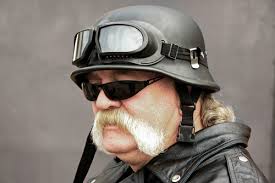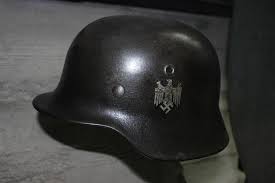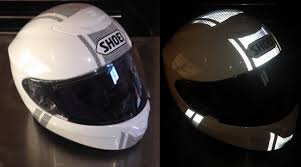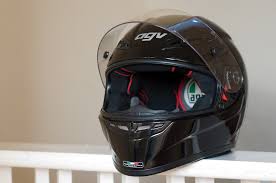Full-face Helmets
 To protect your head, get a full face helmet as most head accidents involve the face. It protects your face and chin from damage and also keeps out wind and road noise. A full-face helmet protects from flying road debris, like stones thrown up by cars. Your eyes are too fragile to ride at speed without a visor. You can buy goggles, but why bother? It is just one more thing to worry about. Wind rush affects your eyes, ears (the noise) and skin. A full-face helmet protects all your head from all the turmoil of riding. Your brain deserves a full-face helmet.
To protect your head, get a full face helmet as most head accidents involve the face. It protects your face and chin from damage and also keeps out wind and road noise. A full-face helmet protects from flying road debris, like stones thrown up by cars. Your eyes are too fragile to ride at speed without a visor. You can buy goggles, but why bother? It is just one more thing to worry about. Wind rush affects your eyes, ears (the noise) and skin. A full-face helmet protects all your head from all the turmoil of riding. Your brain deserves a full-face helmet.
Cap Helmets

Cap helmets just cover the top of the head leaving the face free and open. Since they just cover the top of your head, unless you fall vertically on the top of your head they don’t work. They dont protect your face, and as you ride faster in the rain each drop becomes like a little stone that can hit hard enough to bruise, not to mention a truck in front throwing out a stone into your face. Seeing also becomes difficult, so with a cap helmet you also need goggles. When it rains, cap helmet wearers must “toddle along” because they have no face protection, so cars whoosh past covering them in a dangerous wet flurry.

The popularity of cap helmets seems to be their association with the world war two German army helmets. But while the main danger for infantry is artillery fire from above, a motorcycle rider faces danger mainly from the front. Except for riding in show parades, cap helmets dont do the job.
Helmet fit
A helmet that is too loose, could slip off in a crash, but a helmet that pinches or rubs as you ride is distracting. You want a firm fit, so when you shake your head from side to side, the helmet does not move. Fit a new helmet as snug as you can, as with time the foam padding inside compresses and loosens up.
Helmet visibility

Your helmet should be as visible as possible, so white is the best color and black is the worst from a safety point of view. Does it really matter? Well as explained before, there are no certainties here, only probabilities. If you wear a black helmet will you die? Probably not, because lots of people do, but it is certain that black is harder to see. If you slip in the wet and are lying on the road a white shows up the bit that cars should not hit. One thing for sure, if you are lying on the road, its too late to change your helmet. For me, I always go white for better visibility. Even more important than color is that the helmet is reflective so it shows up at night. Its another feature that doesnt seem important, until it is! Some US states mandate that every helmet must be reflective for safety. It is easy to put tape on the sides and back, so do it.
Visor

The visor is the part of the helmet you see through, so it needs to be scratch proof when hit by sandy bits thrown up on the road. Otherwise over time you wont be able to see through it. Visors also fog up on the inside in hot rainy weather, which is a serious problem because suddenly you cant see at all! Even your breath can fog up a visor in humid weather. The simple way to clear fogging is a good air flow, so check the top and side vents are open. The visor should also click up and down to allow low, medium and high set positions. Then if the vents dont work and the visor fogs, you can click it to the low position to allow more airflow. Check the low setting gives a nice small gap, so the the rain doesn’t force to the inside of the visor, as that also lowers visibility.
Flip the helmet on
To put on your helmet, hold it by its straps in two hands in front of you. Flip the helmet front up to your forehead, then slide it back over your head in one easy back motion. Pushing your hair back like this stops irritating bits sticking out of the helmet. If like me you wear glasses, take them off first and do the above with the glasses in hand. Once the helmet is on, open the visor and slip the glasses back on.
Straps

A good helmet should “click and secure” easily. When someone is injured because their helmet “flew off” in an accident, the straps were not secured properly. The best helmets have a fail-safe, one-click, mechanism. Push the straps together, and the click confirms it is secure. An alternative is the two-ring tie up, where one strap must be folded back through two rings. It works fine too, but depends on you doing it right. Remember that when you do up your helmet you usually cant see what you are doing.
Helmet strap “tug”
It is easy to put your helmet on but forget to tie the straps. Maybe you got distracted. Once you are riding, you may wonder “Did I clip my helmet?”. You cant tell as it feels tight, but in a crash an unclipped helmet could fly off, negating the whole point of having a helmet. If you dont feel like stopping, just pull on the strap with one hand at a safe moment. If it is clipped, you feel the resistance. If not, immediately stop and do it up. Believe me, I am careful, but every so often I forget and ride off with an unclipped helmet, which is like riding with no helmet at all! The helmet strap tug is easy to do while riding, takes just a second, and is always worth doing if you are not sure.